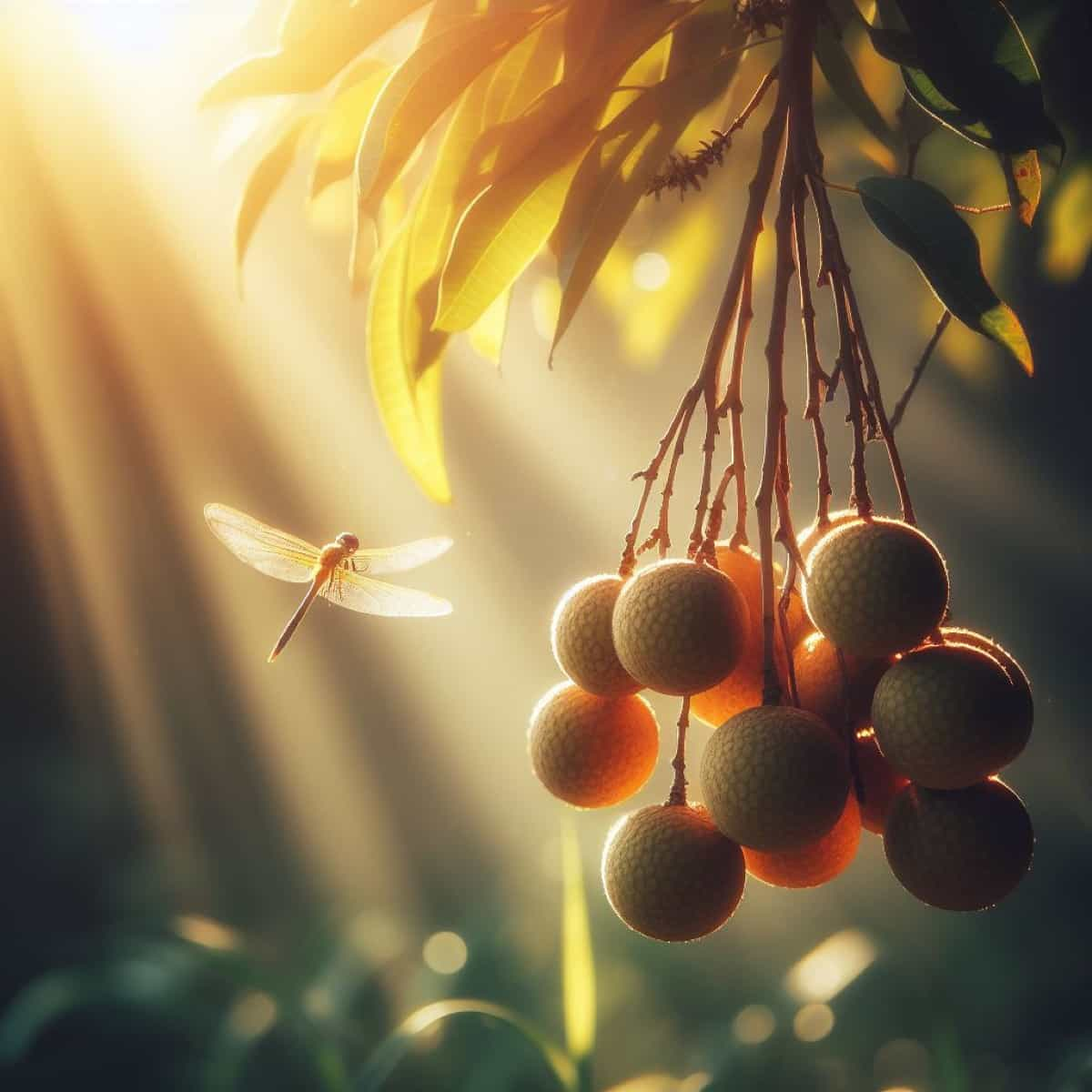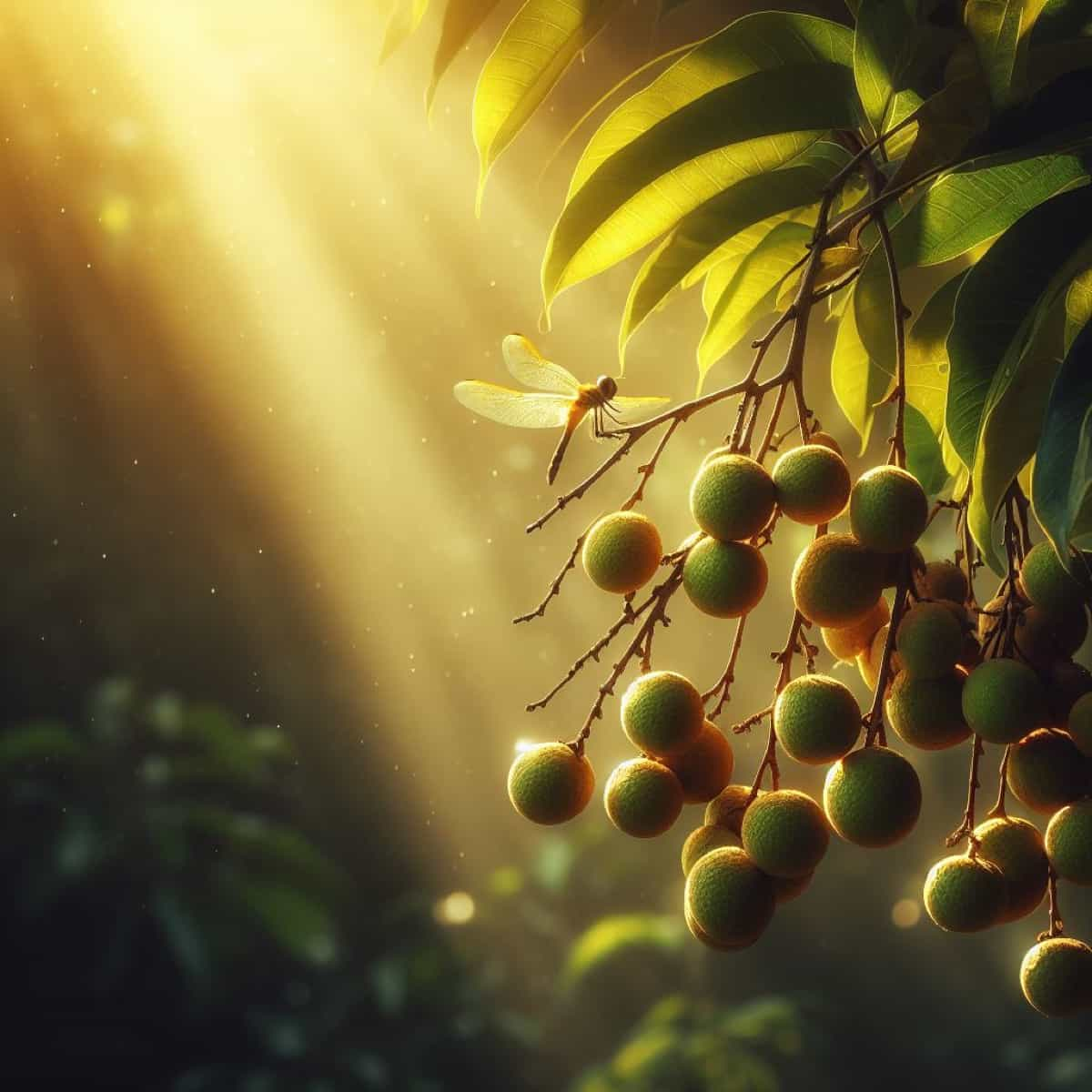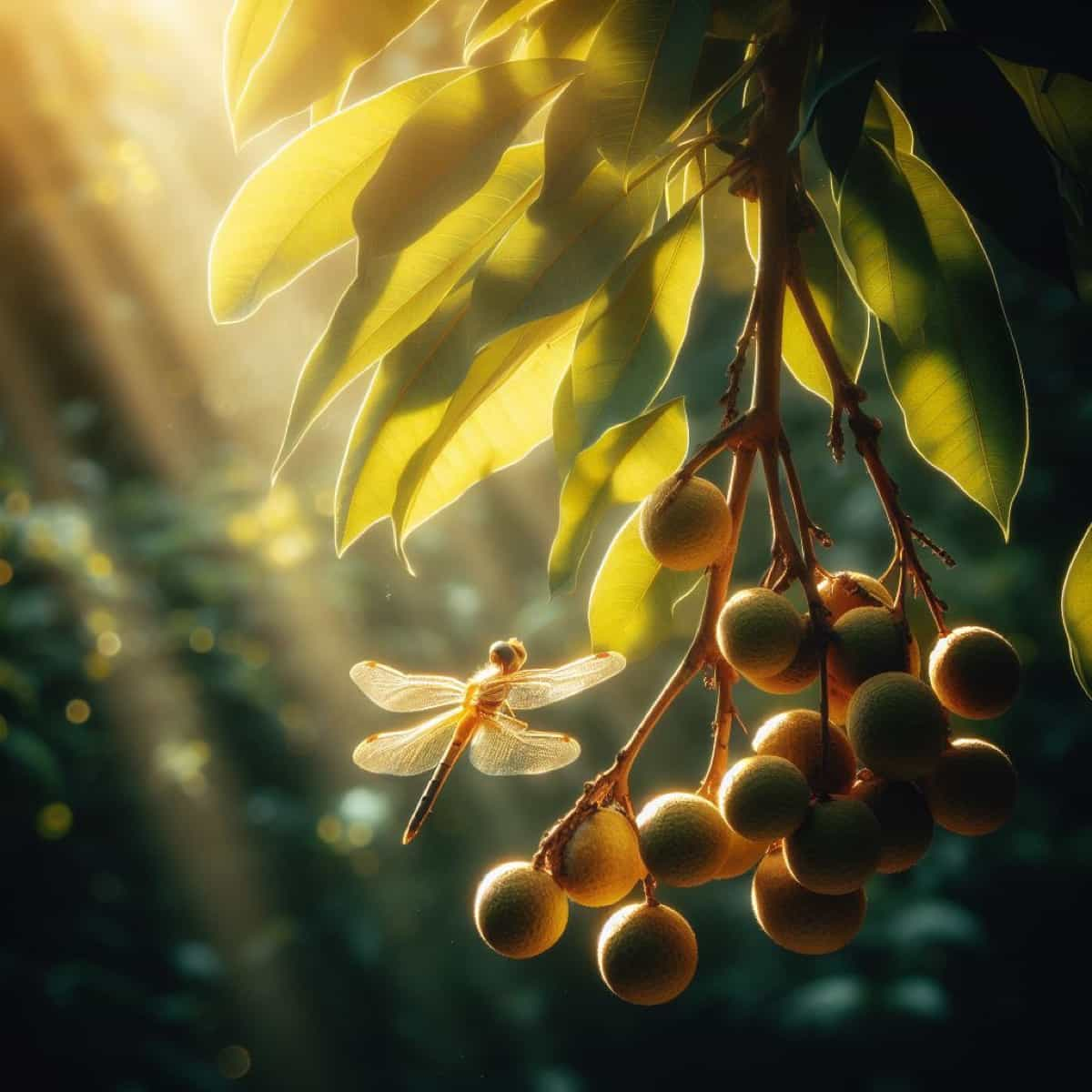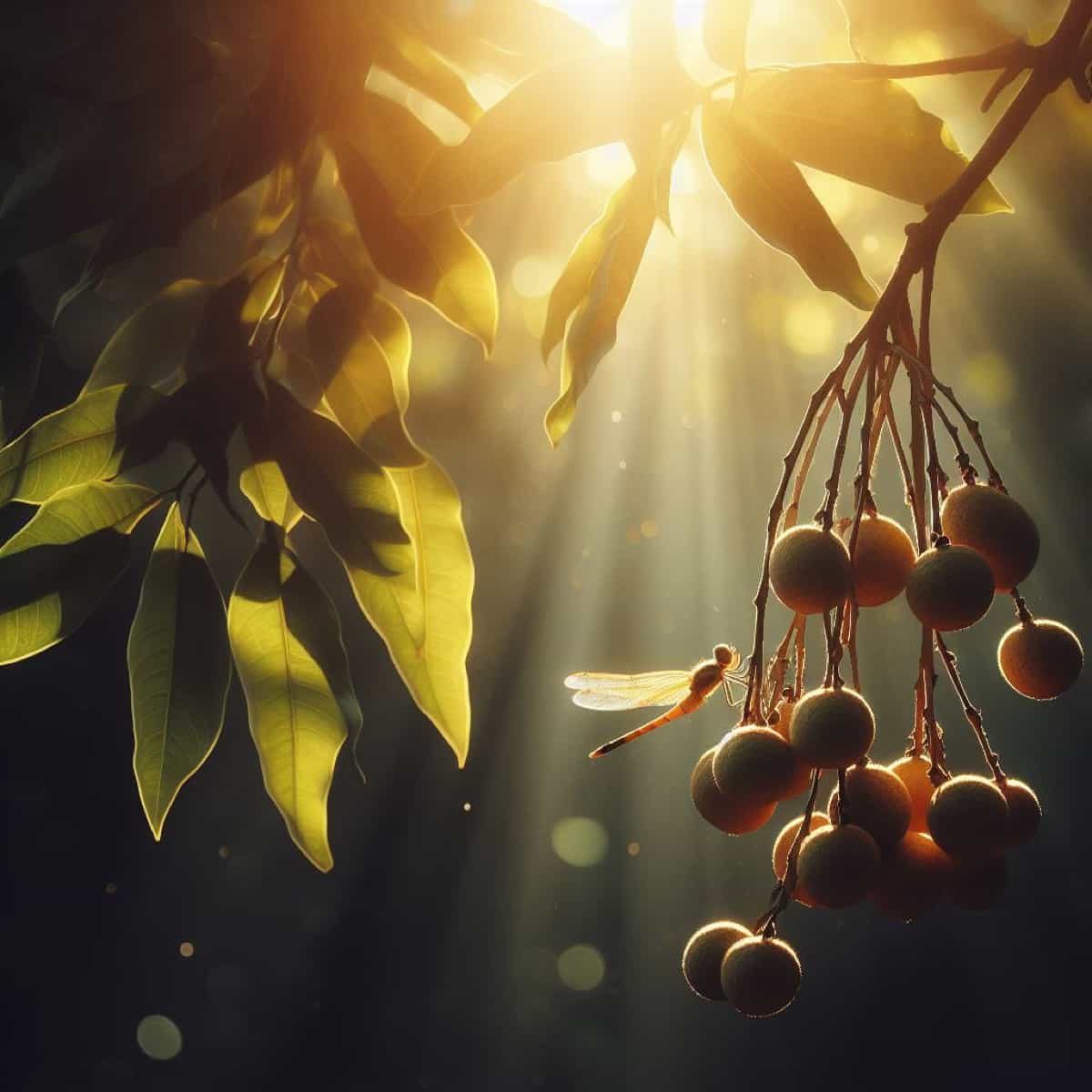Growing Longan trees can be a rewarding experience for any garden enthusiast. With their deliciously sweet and juicy fruit, these tropical trees will make your backyard feel like a little slice of paradise. When finding the right location for your Longan tree, remember that they thrive in warm climates with plenty of sunlight. Make sure you choose a spot that provides protection from strong winds and allows for good drainage.

Once your Longan tree is planted and established, proper care is essential for its growth and productivity. Regular watering, fertilization with balanced nutrients, pruning to maintain shape and health, and adequate pest control measures are all necessary to ensure your Longan tree’s success. Growing Longans requires careful consideration of the location conditions and appropriate propagation methods. However, with some dedication throughout its lifespan, you’ll soon enjoy a bountiful harvest of Longans straight from your garden.
Growing Longan Trees
Right Location for Growing Longan Trees
These tropical fruits require a warm climate with temperatures ranging from 21 to 32°C. They also need plenty of sunlight, so it’s best to plant them in an area that receives full sun exposure throughout the day. Longans prefer well-drained, slightly acidic soil with a pH between 6.0 and 6.5. If your soil isn’t ideal, adding organic matter can improve its drainage.
In case you missed it: Growing Vanilla Beans in Your Garden: A Step-by-Step Guide for Beginners

In addition to sunlight and proper soil conditions, Longan trees also benefit from being protected against strong winds. Planting them near a wall or building can provide some shelter from gusty winds that could damage their delicate branches. Consider the space requirements of mature Longan trees when selecting your planting location. These trees can grow heights of up to 40 feet with spreading branches, so ensure there is enough room for them to grow without being crowded by nearby structures or other plants.
Preparing the Soil for Longan Tree Planting
Before you start planting your Longan tree, it’s essential to ensure that you have prepared the soil properly. This will provide a solid foundation for your tree to grow and thrive. Make sure that the soil is well-drained. Longans prefer slightly acidic soil with good drainage. If your soil tends to be heavy or clay-like, consider adding organic matter to improve its structure and drainage. Longans thrive in a pH range of 6.0-6.5.
Once you know the pH level of your soil, adjust it, if necessary, by adding lime to increase pH or elemental sulfur to lower pH. Follow the instructions carefully and apply the amendments evenly throughout the planting area. It’s also essential to clear any weeds or grass from around where you plan to plant your Longan tree. Weeds compete for nutrients and water, so removing them will give your young tree a better chance of establishing itself successfully.
Propagation Methods for Longan Trees: Seeds vs. Grafting
When it comes to propagating Longan trees, there are two main methods: seeds and grafting. Growing Longans from seeds can be an exciting and rewarding process. Start by collecting fresh seeds from ripe fruits. Clean the seeds thoroughly and soak them in water for about 24 hours to help with germination. Then, plant the seeds in a well-drained soil mix and keep them moist. It may take several weeks or months for the seeds to sprout, so patience is critical.
On the other hand, grafting offers more control over the growth of your Longan tree. This technique involves joining a scion (a desired variety) onto a rootstock (a hardy base). Grafting allows you to reproduce specific traits of a certain cultivar or improve overall tree health using disease-resistant rootstocks. While grafting requires more skill and knowledge than seed propagation, it can result in faster growth, earlier fruit production, and consistent quality across multiple trees.
In case you missed it: How to Grow Tomatoes in Grow Bags: Planting from Seed, Growing, and Care

Watering Requirements for Longan Trees: Best Practices
Watering is a key aspect of caring for Longan trees. These tropical beauties have specific water requirements that must be met to thrive. First and foremost, it’s essential to understand that Longans prefer moist but well-drained soil. Overwatering causes root rot and other fungal diseases, so you’ll want to strike a balance. One way to ensure proper drainage is by planting your Longan tree on slightly elevated ground or in a raised bed.
When it comes to frequency, young Longan trees require more frequent watering compared to established ones. Typically, you’ll want to water your young tree every 2-3 days during the first year of growth. As the tree matures, you can gradually reduce the frequency and water once every 7-10 days. In terms of quantity, aim for deep watering rather than shallow sprinkling. Longans have extensive root systems that benefit from deep water penetration into the soil. Water should reach at least 1 foot below ground level during each watering session.
Fertilizing Longan Trees: Nutrient Needs and Schedule
| Nutrient | Purpose | When to Apply |
| Nitrogen | Promotes leaf growth | Early spring, after pruning. |
| Phosphorus | Supports root development | Before planting or during early spring. |
| Potassium | Enhances fruit quality | After flowering and before the fruit set. |
| Calcium | Prevents blossom-end rot | Throughout the growing season, as needed. |
| Magnesium | Aids chlorophyll production | In late winter or early spring. |
Pruning and Training Longan Trees for Optimal Growth
Pruning and training are essential for promoting optimal growth in Longan trees. By carefully shaping the tree, you can encourage better airflow and sunlight penetration, leading to healthier foliage and improved fruit production. When pruning Longan trees, it’s essential to start early. Begin by removing any damaged branches to prevent disease spread. Additionally, thin out crowded areas for better air circulation throughout the canopy. Consider using stakes or trellises for support to train your Longan tree into a desired shape.
In case you missed it: How to Grow Serviceberries in a Home Garden: A Step-by-Step Guide

This will help guide the growth of the main trunk and branches, ensuring a strong structure that can withstand heavy fruit loads in the future. Regular pruning should be done when the tree is not actively growing during the dormant season. Trim back excessive growth and remove any crossing or rubbing branches that could cause damage or hinder proper development. Remember that each cut you make impacts the overall form of your Longan tree. Make clean cuts at appropriate angles above a bud or lateral branch junction for optimal healing and regrowth.
Protecting Longan Trees from Pests and Diseases
Gardeners must take proactive measures to protect their Longan trees from these threats. One common pest that affects Longan trees is the Longan fruit borer. These small insects lay eggs on the young fruits, hatching them into larvae that bore into the fruit, causing damage and affecting their quality. To prevent infestation, regular inspection of the fruits is necessary. If any signs of borer activity are detected, prompt removal or treatment with organic insecticides can help control the problem.
Another significant threat to Longans is fungal diseases such as anthracnose and powdery mildew. Anthracnose causes dark spots on leaves and fruits, while powdery mildew looks like a white powdery substance on leaves. To prevent these infections, it’s crucial to maintain good air circulation around the tree by pruning away crowded branches. Applying fungicides at appropriate intervals during periods of high humidity can also help prevent fungal diseases. Additionally, practicing proper sanitation by removing fallen leaves and debris around the tree will reduce potential sources of infection.
Harvesting Longans: Signs of Ripeness and Proper Techniques
When it comes to harvesting Longans, timing is everything. Pay attention to the color of the fruit. Ripe Longans will have brownish-yellow skin that easily peels away from the flesh inside. If you notice any green or unripe-looking spots on the skin, it’s best to leave them on the tree a little longer. Another clue that your Longans are ready for harvest is their size and weight. Mature fruits tend to be larger compared to their younger counterparts. Additionally, they should feel slightly heavy in your hand when you pick them up.
In case you missed it: How to Plant and Care for Wisteria: Growing Instructions

Now, let’s talk about proper harvesting techniques. To avoid damaging the delicate fruit, use pruning shears or sharp scissors instead of pulling at them with your hands. Cut off each cluster carefully without harming neighboring branches or buds. It’s also important not to rush this process – take your time and carefully handle each Longan. Once harvested, place them gently into a basket or container lined with soft materials like foam or tissue paper. Remember that Longans don’t ripen after being picked, so choosing non-matured ones for consumption or storage for essential purposes is crucial.
Storing and Preserving Longans: Tips for Extended Shelf Life
Pick Longans when they are fully ripe but still firm. Avoid harvesting overripe or damaged fruits, as they will spoil quickly. Longans have delicate skins that can bruise easily, so handle them gently when picking or storing. Rinse the Longans with cool water to remove dirt or debris before storing them. Longans prefer temperatures between 10-13°C.
Keep them away from direct sunlight, as it can cause them to ripen too quickly. Store Longans in a well-ventilated container to maintain airflow and prevent moisture buildup. Make sure not to pack the Longans tightly together, as this can lead to accelerated spoilage due to increased ethylene production. Inspect your stored Longans frequently and immediately remove spoiled fruits to prevent contamination.
Longan Tree Varieties
- Kohala: This variety is known for its large fruit size and sweet flavor. It is a vigorous grower and produces high yields.
- Biew Kiew: Biew Kiew Longans are prized for their small to medium-sized fruit with thin skin and translucent flesh. They have a delicate sweetness that many people enjoy.
- Chompoo: Chompoo Longans have a distinct reddish-pink color when ripe, making them visually appealing. They have a rich, sweet taste that is highly sought after.
- Diamond River: Diamond River Longans are known for their large fruit size and exceptional sweetness. They have a smooth texture and are often used in desserts or eaten fresh.
Frequently Asked Questions (FAQ) on Growing Longan Trees
Can I Grow Longan Trees in My Backyard?
Absolutely! Longan trees can thrive in various climates but prefer tropical or subtropical regions. You can successfully grow Longans in your backyard if you provide them with the right conditions, such as adequate sunlight and well-drained soil.
In case you missed it: Thriving Under Glass: Unleashing the Power of Organic Greenhouse Growing Techniques

How Tall Do Longan Trees Typically Grow?
Longan trees are medium-sized evergreen trees that can reach up to 40 feet if left unpruned. However, with regular pruning and training, you can control their size and shape to fit your garden space.
Do I Need Multiple Longan Trees for Fruit Production?
No, you don’t necessarily need multiple Longan trees for fruit production. While cross-pollination may increase fruit set and yield, some varieties are self-fertile and can produce fruits independently.
How Much Time Does it Take for a Longan Tree to Bear Fruit?
The time it takes for a Longan tree to bear fruit can vary depending on its age and growing conditions. Generally, you can expect a young Longan tree to start producing fruits within 5-6 years after planting.
Do I Need More Than One Longan Tree for Pollination?
No, you don’t necessarily need multiple trees for pollination in the case of Longans. Unlike some other fruit trees, most varieties of Longans are self-pollinating, meaning they have both male and female flowers on the same tree. This makes them capable of setting fruit without cross-pollination from another nearby plant.
How Often Should I Water My Longan Tree?
Proper watering is essential for healthy growth and fruit production in Longan trees. During hot and dry periods, watering your young saplings regularly is recommended – about once or twice a week.
Conclusion
Growing Longan trees in the garden can be a rewarding and enjoyable experience. You can cultivate these delicious fruits at home with the right location, soil preparation, and care. Whether you grow from seeds or opt for grafting, understanding the propagation methods will help ensure successful growth.
Once your Longans are ripe and ready for harvest, use proper techniques for picking them off the tree. And if you want to enjoy their sweet flavor year-round, follow storage tips that will extend their shelf life. Explore different Longan tree varieties available based on your region’s climate conditions. This way, you can select the type best suited for your garden.
- Flower Garden Designs and Layouts for Beginners
- Planting and Spacing Techniques in Papaya: A Beginner’s Guide
- Growing Gold: Essential Techniques for Planting Pineapples
- How to Make Kalanchoe Plant Bushy: Home Remedies and Solutions
- 11 Reasons Why Your Gardenia is Not Blooming: Home Remedies and Solutions
- Eco Elegance: The Guide to Designing a Drought-Tolerant Landscape
- Gardening on a Slope: Strategies for Hillside Landscaping
- Nourish and Flourish: Top Organic Mulches for Thriving House Plants
- Everything You Want to Know about Indian Mogra Flower: Discover Uses and Growing
- Green Thumb Success: Expert Tips for Cultivating Greenhouse Pumpkins All Year Round
- Maximize Growth & Flavor: The Ultimate Guide to Companion Planting in Herb Gardens
- How to Control Rhododendron Problems Naturally: Home Remedies and Organic Ways to Fix Them
- Natural Magic: The Remarkable Benefits of Cinnamon for Plants
- Best Steps to Revive Dying Tulip with Natural and Organic Treatment
- 10 Reasons Why Your Angel Trumpet is Not Blooming: Remedies and Treatment
- How to Fix Periwinkle Leaf and Flower-Related Problems: Natural Remedies and Solutions
- How to Fix Zinnias Leaf and Flower Problems: Discover Natural and Home Remedies
- Organic Steps to Induce Lemon Tree Flowers: A Comprehensive Guide
- Bloom Booster: Crafting the Perfect Homemade Bougainvillea Fertilizer
- Optimizing Growth: A Guide to Applying NPK Fertilizer for Potted Plants
- 10 Best Homemade Fertilizers for Rubber Plant: DIY Recipes and Application Method
- How to Boost Female Pumpkin Flowers: Effective Steps for More Flowers and High Yields
- Transform Your Indoor Garden: Top Benefits of Pink Salt for Houseplants
- 10 Best Homemade Fertilizers for Peacock Plants (Calathea): Easy DIY Guide
- Unlock Blooms: 9 Reasons Why Your Potted Chrysanthemum is Not Blooming
- 8 Reasons Why Your Potted Hibiscus is Not Blooming: Fix it with Simple Solutions
- Unlock Blooms: 9 Key Reasons Your Potted Frangipani Won’t Flower
- 10 Reasons Why Is My Ice Plant Not Blooming: Remedies and Treatment
- 10 Reasons Why My Potted Hydrangea Not Blooming: Treatment and Remedies
- 10 Reasons Why is My Wisteria Not Blooming: Remedies and Treatment
- 10 Reasons Why is My Goldfish Plant Not Blooming: Remedies and Treatment
- Maximize Your Space: Ultimate Guide to Balcony Gardening with Grow Bags
- 10 Reasons Why Your Iris is Not Blooming: Remedies and Treatment
- 10 Reasons Why Your Anthurium Plant is Not Blooming: Treatment and Remedies
- 10 Reasons Why Your Aquaponic Plants Are Not Flowering: Remedies and Treatment
- 10 Reasons Why Your Agapanthus is Not Flowering: Remedies and Treatment